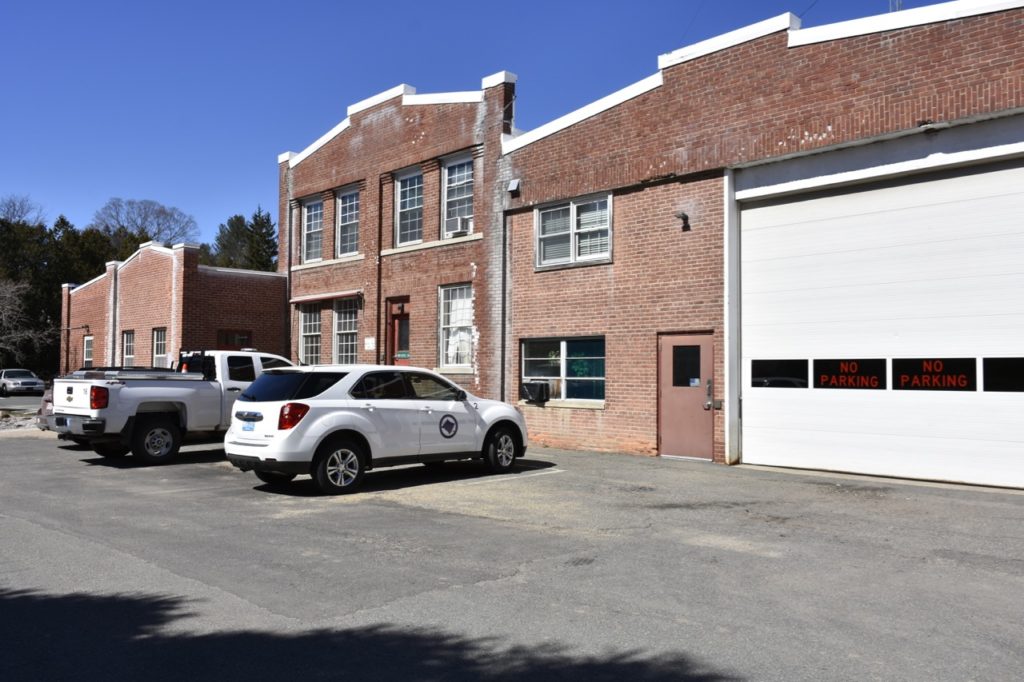AMHERST UNABLE TO FUND FOUR MAJOR CAPITAL PROJECTS AT ONCE: State Law Caps Borrowing at $105 Million

Site of the current DPW, slated for replacement in the capital plan. Photo: Art Keene.
by Toni Cunningham
The five-member Finance Committee of the Amherst Town Council recently learned that the town cannot simultaneously fund the four major capital projects now proposed, and was advised to scale back and separate them.
Despite the optimism publicly expressed by town officials in recent years, Amherst is facing fiscal constraints including limits to its borrowing capacity.
Estimates from feasibility studies have priced a new Department of Public Works (DPW) building at $38 million, a South Amherst fire station at $24M, and the Jones Library renovation and expansion at $36 million. In a presentation to the Finance Committee on March 12, Capital Projects Director Sean Mangano listed multiple options for the fourth major capital project—addressing Wildwood and Fort River elementary schools—the least expensive of which is $82 million for a single new 600-student K-5 school, with 6th graders town wide moving into Amherst Regional Middle School.
When the cost of each project estimate is escalated to the most likely year of construction, the total principal cost is over $200 million. Assuming state grants are received for the library and school, the net cost to the town would be about $150 million. This far exceeds the town’s maximum debt capacity of $105 million. State law limits a town’s debt capacity to 5 percent of Equalized Valuation (EQV), which is the estimated value of all taxable property in the town.
In order to fit all four projects well under the debt ceiling, Mangano advised that the town scale back the projects and space them out more. Using an interactive planning tool, Mangano demonstrated different combinations of projects, costs, and timelines. One such combination reduced the DPW to a 2025 cost of $30 million, the Fire Station to a 2027 cost of $20 million and the library to a 2023 cost of $10 million. If the library were to be limited to a budget of $10 million, it would effectively mean dropping the expansion plans and instead repairing the existing building.
According to Mangano, the town’s ongoing capital needs also come out of the same pot of money. This includes roads, sidewalks, building maintenance, and equipment, as well as a growing number of other smaller projects, including redesign and repair of the North Amherst intersection, the North Common, the high school athletic fields, the Station Road bridge, and new sidewalk projects. Mangano proposed cutting the ongoing capital allocation in half in order to allocate enough funds to cover the major project debt, a change that could hinder the town’s ability to maintain infrastructure, undertake other projects, or deal with emergency situations.
At a town budget forum on March 7, Town Manager Paul Bockelman highlighted roads, sidewalks, and crosswalks as priorities, as well as the four major construction projects, although no cost estimates were discussed. The intention of the sparsely-attended forum was to hear from the community what their priorities are with the budget. An online form has been created for residents to share their budget priorities with the Town.
Mangano’s model included debt exclusions for the school and library, which would result in property tax increases exceeding $500 on the average home. Mangano will make his interactive tool available to Finance Committee members first and subsequently to the public so that anyone can explore scenarios for funding the major capital projects.
